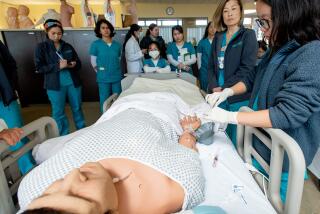Increases in Fees Expected to Have Major Impact at 2-Year Colleges : Enrollment: Educators worry most about the effect of the $50-a-unit cost imposed on students who already have BA degrees or higher.
Judy Greenberg of Van Nuys, a former speech therapy and audiology teacher, has all but abandoned her dream of having a second career.
âI will not be coming back to school next semester,â said Greenberg, who has been taking courses toward becoming an English as a Second Language instructor at Valley College in Van Nuys.
The new $50-a-unit fee she would be charged to continue taking classes at Valley is âa tremendous increase and one that I cannot afford,â Greenberg said. âWe have to be thinking about economizingâ because her husband is considering retirement.
Educators and students in the San Fernando, Santa Clarita and Antelope valleys fear that stiff fee increases imposed by the Legislature on community college students to balance this yearâs state budget will cause thousands of students to drop out--particularly those who, like Greenberg, have bachelorâs degrees or higher.
âIâm quite certain our enrollment will go down,â said Lowell Erickson, president of Pierce College in Woodland Hills.
Beginning with the spring semester in January, students with bachelorâs degrees or higher, with some exceptions--such as the unemployed and those on welfare--will pay $50 a unit for classes at two-year colleges. Previously, they were charged $6 a unit, the same as other students.
Students without degrees will pay higher fees of $10 a unit with no maximum limit, which some fear may also prompt some lower-division students to drop out of school. The fees for undergraduates had been limited to $60 no matter how many classes they took each semester.
âWith the economy being the way it is now, the lifting of the limit, weâre just not sure how itâs going to impact our students,â said Steve Standerfer, spokesman for Antelope Valley College in Lancaster.
âItâs not unusual for our students to take 18 or 20 units a semester. Now, a student pays $60 to take 18 units. Next semester, itâll be $180. Thatâs a huge increase.â
Carlos Nava, dean of students at Mission College in Sylmar, predicted that even if students continue their educations, they will take fewer classes a semester.
âStudents will not enroll in the number of units they have in the past because thereâs no upper limit on fees,â he said. âThey wonât be able to afford it. Weâre going to feel the sting.â
Any decline in enrollment could also mean less money for the already financially strapped colleges, which receive a certain amount from the state for each full-time student.
But it is the effect of the $50-a-unit fee that students who already have degrees will have to pay that worries most educators.
âIt seems to say that you cannot grow any more, you cannot learn,â said Adrienne Zahler, director of the speech lab at Valley College. âYouâre certainly pricing many people out of education.â
In fact, estimates of the numbers of students with degrees attending area community colleges surprised many administrators. For example, a survey that showed Valley College had more than 2,000 students with bachelorâs degrees or above--about 11% of the total enrollment--prompted administrators there to mail recruitment brochures to attract potential students for the first time in years.
âWe felt this could cause quite a dip in our enrollment and it was a good time to recruit new students,â said Shannon Stack, head of instructional media services at Valley College.
Stack said the brochures are aimed at attracting new students to replace those the college fears that it might lose to the higher fees.
Estimates at most other schools showed somewhat lower percentages. A Los Angeles Community College District survey found 1,673 students with higher education degrees at Pierce--8.7% of the enrollment--and 542 of 6,900 students at Mission College, or about 7.8%.
Antelope Valley College sent letters to almost 600 of its more than 10,000 students, explaining that they may be required to pay the higher fee. âThese are only the ones we know about,â Standerfer said. âWe think there are quite a few others.â
College of the Canyons in Santa Clarita mailed similar letters to 950 of its 6,500 students, or almost 15% of the schoolâs enrollment.
Many educators said Gov. Pete Wilson and the Legislature donât understand the role of community colleges.
âItâs a complete misunderstanding on the stateâs part,â Erickson said. âThese are not just people who are taking a Spanish course because theyâre taking a trip to Mexico.
âThey are serious students. Many canât get jobs and are changing careers. Naturally, those people donât have much money. They canât afford to pay $750 to $1,000 a semester. One of our concerns is our nursing program.â
âIâm terribly sorry the differential fees have been implemented,â said Carter Doran, vice president of instruction and student services at College of the Canyons. âThey may very well interfere with one of our basic college tenets--access to all.â
James Hicks, chairman of Valley Collegeâs computer science department, said many of his students with degrees are already working in the computer industry. âThey are taking courses to further themselves in their current professions,â he said.
But Hicks said he fears that quite a few will not return. âI have had one student in the office talking to me about not coming back,â he said. âHeâs already working and is trying to get into a different aspect of the industry. He canât afford the new fees with the expense of books and all.â
Books for one class can run as much as $200 a semester, Hicks said.
Doran said students pursuing careers in the child development and nursing programs will be affected most at College of the Canyons. âMany wonât be able to afford the higher fee.â
He and others also predicted that the higher fees will change demographics at community colleges.
âYouâll be getting the more affluent students,â College of the Canyons spokeswoman Sue Bozman said.
Erica L. Hauk, student member of the Los Angeles Community College District Board of Trustees, took that concern a step further.
âWeâll be seeing more of the white, middle-class students rather than the lower-income minority students in community colleges,â she said. âI see this as closing the doors to people who need the education the most.â
Nava said he hopes that most of Missionâs students with higher degrees will qualify for the exemptions spelled out in the legislation that raised the fees. Under the new law, students with bachelorâs degrees or above who are displaced workers without a job, who are on welfare or other public assistance or who are âdisplaced homemakersâ will not be charged the $50-per-unit fee.
The definition of a displaced homemaker is somewhat vague. According to the law, the term means an individual who:
* Has not worked in the labor force for a substantial number of years, but who has worked in the home providing unpaid services for family members.
* Has been dependent on public assistance or on the income of another family member but is no longer supported by that income, or is receiving public assistance on account of dependent children in the home.
* Is unemployed or underemployed and is experiencing difficulty in obtaining or upgrading employment.
âIt has to be all three,â Nava said. âNot just one. Some of the requirements are contradictory. This has to be clarified.â
Nevertheless, he said, Mission College administrators believe that the majority of the schoolâs students with higher degrees are eligible for the fee exemptions because the school is in a low-income area.
More to Read
Sign up for Essential California
The most important California stories and recommendations in your inbox every morning.
You may occasionally receive promotional content from the Los Angeles Times.










